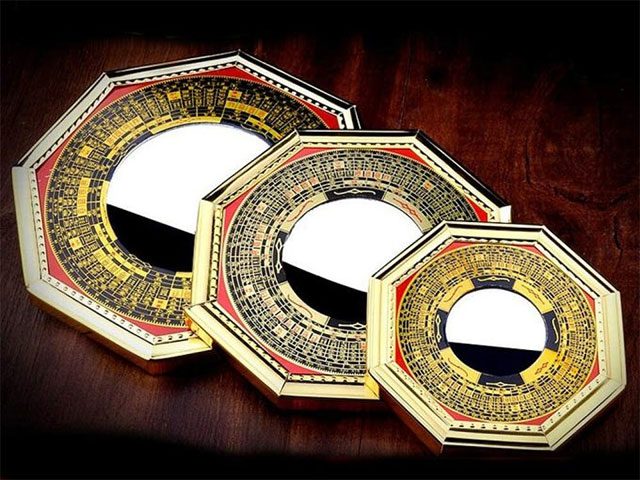Using the excuse of “feng shui,” many people present superstitious views regarding the hanging of the Bagua mirror.
They believe that the Bagua mirror is a feng shui tool that gathers the five elements of feng shui, the Lo Shu grid, and the Bagua diagram, and should be used to remedy, protect, or neutralize negative energies for homes with unfavorable orientations, such as houses near cemeteries, railway tracks, overpasses, intersections, or places with large trees (which can affect health, wealth, and career).
In reality, the Bagua mirror, like various other feng shui objects such as zodiac statues, Pixiu, five-coin money, copper or crystal gourd, seven-star array, wish-fulfilling jade, Wen Chang pagoda, feng shui wheel, bronze guardian lion, toad, feng shui salt, talisman powder, and purification powder, is not a true feng shui tool.
There is no official record of the origins of the Bagua mirror. Folklore suggests that many ancient Taoist priests used an eight-sided piece of peach wood, smoothed on both sides, with eight trigrams carved on it representing the eight directions of the universe (or used a wooden sword made from peach wood) during their spiritual practices.
Enlightened Taoist priests often used these two types of “weapons” or a whisk to subdue demons and conduct rituals. The piece of peach wood gained fame due to the “divine power” of the priest. It is called the Bagua mirror because it features the eight trigrams carved on its surface (it is referred to as the Tai Chi mirror when it has the sun and moon depicted on it). The power of the Bagua mirror is essentially the spiritual energy derived from the Taoist’s cultivation.

The Bagua mirror is not a feng shui tool. (Image: Amazon)
In modern times, Bagua mirrors are made from glass or metal, decorated according to various folk beliefs, and come in a wide variety of artistic and decorative styles.
Today, the Bagua mirror is merely an object with reflective or converging light properties (if produced as a converging lens), and should thus be used as a mirror (glass) in interior and exterior decoration.
The Bagua mirror does not possess the ability to neutralize negative energy, ward off evil, stabilize a location, or enhance prosperity; it also cannot harm neighbors. In cases where psychological factors need to be addressed, it can be applied. For example, in homes that are affected by negative energies such as piercing energy, direct conflict energy, celestial energy, heavenly cutting energy, light energy, or projectile energy… after addressing the negative energies according to feng shui principles, a Bagua mirror may be hung to “perform a ritual.”
When purchasing and hanging a Bagua mirror, it is important to note that a “standard” Bagua mirror always has the Qian trigram carved at the top, representing the head of the white fish in the Tai Chi diagram; and the Kun trigram carved at the bottom, representing the head of the black fish. The house or door, regardless of its orientation, must have the mirror hung correctly with Qian (at the position of the white fish’s eye) and Kun (at the position of the black fish’s eye) aligned on a straight line. Any new creations of Bagua mirrors, with trigrams and designs not in the correct positions, should not be used.
Cultural researcher Pham Dinh Hai

















































